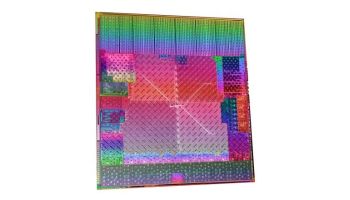Intel And AMD Cross Swords Over Integrated Graphics

Upcoming processors were featured by Intel and AMD at the Intel Developer Forum to display CPUs with GPUs on the same die
Intel and Advanced Micro Devices (AMD) are about to see their competitive relationship heat up further as they prepare to roll out new processors that include on-chip graphics technology.
Intel executives put their upcoming Sandy Bridge second-generation Core architecture on centre stage during the Intel Developer Forum. The 32-nanometre chips, which should start appearing in systems in early 2011, will offer the CPU and graphics processing unit (GPU) on a single piece of silicon.
The move is designed to improve tasks such as high-definition video, 3D rendering, gaming, social networking and multimedia. Removing the discrete graphics card and putting those capabilities on the die with the CPU will also lead to space savings and greater energy efficiency.
AMD Chips In At IDF

In a hotel suite near the IDF event at the Moscone Centre in San Francisco, AMD showed off one of its upcoming Accelerated Processing Units (APUs), AMD’s name for chips with integrated GPU capabilities, called the Zacate. At the demonstration company officials said it showed their chip running significantly faster than Intel’s current Core i5 processor.
The AMD Zacate processor is an 18W chip for notebooks and desktop PCs. For netbooks and smaller form factors, there will also be a 9W chip called Ontario. Both are part of what AMD is calling the Brazos APU platform and systems built around them will appear next year.
Bob Grim, AMD’s director of client platform marketing, said the APU chips are the culmination of a vision the company had four years ago when it bought ATI. Last year, CEO Dirk Meyer announced that AMD was essentially combining its CPU and GPU businesses as it marched toward an integrated platform. Just last month, AMD said it was phasing out the ATI name so that all their products would be identified with the AMD brand.
AMD has been criticised by some analysts for being late with its APUs, which were first expected to appear in 2008, and allowing Intel to catch up. In an interview with eWEEK, Grim said that while systems with AMD’s APUs would be coming out about the same time as those with Intel’s Sandy Bridge, there were some key differences, including the positioning of the processors.
Grim said the expectation is that Sandy Bridge will appear in high-end PCs first and then cascade down to the midrange later. In contrast, Zacate will appear in systems in the $500 range.
“We’re bringing it in at the heart of the mainstream market,” he said. This will enable a large number of customers, looking for a high-performing, energy-efficient system with high-end graphics capabilities, to buy one immediately as an AMD-powered system, he added.
In the demonstrations, AMD ran a Zacate chip against a 2.4 GHz Core i5 from Intel. Grim would not disclose details of the Zacate chip, not even its speed.
In one demo, using the video game “City of Heroes” from NcSoft, the frame rate on the Zacate chip was about double that of the Core i5. Using a beta version of Microsoft’s Internet Explorer 9 browser, Zacate’s speed was about three times that of the Intel chip when running the Amazon Shelf performance test.
In a third test showing a spinning wheel of colour, Zacate again beat the Intel chip.
Grim conceded that the Zacate processor was running against an existing Intel chip that did not have the strong integrated graphics of Sandy Bridge, but noted that while the system with the Core i5 processor sold for about $800 on the market, a faster Zacate-based PC would come in at around $300 less.
In a research note regarding Sandy Bridge, Charles King, an analyst with Pund-IT Research, noted the promise that the integrated graphics capabilities held for Intel but pointed out the competition it faced. This will come not only from AMD but also the likes of discrete graphics vendor Nvidia and Qualcomm with its Snapdragon processors based on ARM designs.